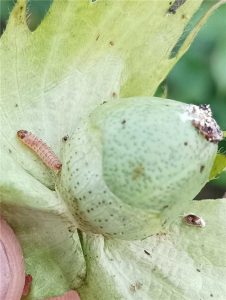Pink bollworm (Pectinophora gossypiella) is a serious pest that affects cotton crops. The name “pink bollworm” refers to the pinkish hue of its larvae, which are caterpillars responsible for the most significant damage to cotton plants. It primarily infests the buds, flowers and bolls, causing substantial economic losses for cotton farmers. This pest is most active during the fruiting period of the cotton plant. It is expected to cause yield loss of more than 50%, if not managed.
Explore valuable insights into identifying pink bollworm infestation, accompanied by effective integrated pest management strategies. Also, discover how Bt cotton delivers a knockout blow to pink bollworm, reducing reliance on chemical insecticides and safeguarding your cotton crops.
Symptoms of Pink Bollworm in Cotton

- Pink bollworm larvae bore into the cotton bolls and feed on the seeds and lint inside, leaving holes and tunneling marks.
- The entry holes created by the larvae provide entry points for bacteria and fungi, leading to secondary infections.
- They also feed on the flower buds and the affected flowers do not open, giving ‘rosette appearance’.
- The larvae may create silken webbing within the cotton bolls. This webbing can be visible inside the bolls or between damaged bolls, indicating their presence.
- The larvae and pupae can be found inside the bolls, and they are often pink in colour.
- The burrowed holes are plugged by excreta (frass) of larvae due to their feeding inside seed kernels.
- Infested bolls may open prematurely before reaching maturity. This exposes the seeds and lint to further damage from pests and environmental factors.
- Premature dropping of infested buds and immature bolls.
- It bores into bolls, through the lint and feeds on the cotton seeds. The seeds are destroyed and lint gets discoloured.
Economic Threshold Level (ETL)
If you observe 10% of affected flowers (rosette flowers) or 10% of green bolls with damage (at least 2 bolls out of 20 showing white or pink larvae or exit holes), or if you capture 8 moths per night in a pheromone trap for three consecutive days.
(*ETL – It is the pest population density or crop damage level at which the control measures need to be determined to prevent the increasing pest population)
Effective Management Strategies to control Pink Bollworm in Cotton
Cultural Control
- Grow resistant varieties such as Bhakti cotton, Asha NCS 9011 BT-2 hybrid cotton seed.
- Deep plough the soil during summer to expose and kill the pupa.
- Crop rotation with soybean, maize or sorghum in alternate years can help to break pest’s lifecycle.
- Plant early maturing cotton varieties to avoid the peak season of pink bollworm infestation.
- Sow 5 rows of non-Bt cotton seeds at the borders. These will act as trap crop and attract the pink bollworms.
Mechanical Control
- Destroy crop debris immediately after harvesting.
- Remove and destroy alternate host of pink bollworm like okra.
- Collect and dispose the fallen flowers, squares and bolls in the field.
- Set up pheromone traps from 45 days after sowing or at flowering stage to till harvesting for monitoring the moth activity of pink bollworm.
- For this purpose, install 6 – 7 Tapas Pink Bollworm lure with Funnel trap or 10 – 12 Gaiagen Pink Bollworm Lure & Insect Funnel trap for 1 acre field. This helps in mass trapping and destruction of pink bollworm.
Biological Control
- Spray neem oil (5 ml/lit of water), 60 days after sowing.
Enhance pink bollworm control by spraying any of these biological agents in your cotton field at regular intervals;
| Product name | Technical name | Dosage |
| Multiplex Metarhizium Liquid | Metarhizium anisopliae
|
10 gm/lit of water |
| Katyayani Organic Larvicide | Bacillus thuringiensis var kurstaki | 10 ml/lit water |
| Royal Larvend | Plant extracts | 2ml/lit of water |
| Tracer Insecticide | Spinosad 44.03% SC | 0.4 ml/lit of water |
Chemical Control
Initiate chemical control methods only when the pest population exceeds the economic threshold level (ETL). Avoid continuous use of chemical pesticide sprays and instead employ them in a rotational manner based on necessity.
| Product name | Technical name | Dosage |
| Proclaim Insecticide or | Emamectin Benzonate 5% SG | 0.5 gm/lit of water |
| EM 1 Insecticide | ||
| Ekalux Insecticide | Quinalphos 25 % EC | 2 ml/lit of water |
| Ampligo Insecticide | Chlorantraniliprole10 % + Lambdacyhalothrin 5% ZC | 0.5 ml/lit of water |
| Takumi Insecticide | Flubendiamide 20% WG | 0.5 gm/lit of water |
| Lancer Gold Insecticide | Acephate 50 % + Imidacloprid 1.8 % SP | 2 gm/lit of water |
| Koranda Insecticide | Chlorpyrifos 50% + Cypermethrin 5% EC | 1.5 ml/lit of water |
| Tatafen Insecticide | Fenvalerate 10 % EC | 2.5 ml/lit of water |
| Gharda Kite Insecticide | Indoxacarb 14.5% + Acetamiprid 7.7% SC | 1 ml/lit of water |
(*Note: Check the product’s label to follow the right time of application. Use a combination of cultural, mechanical and biological measures along with chemical control for effective management.)
Learn How to Manage Other Major Insect Pests in Cotton – Click here
Ever wondered about the role of genetically modified Bt cotton in controlling pink bollworm?
Bt cotton contains genes from Bacillus thuringiensis (Bt) bacterium, producing proteins (Cry toxins) toxic to pink bollworm and other pests. When pink bollworm larvae consume Bt cotton, these proteins disrupt their digestion and cause their death. The targeted action of these proteins minimizes the use of broad-spectrum insecticides, reducing harm to beneficial insects and environmental risks.
Bt cotton reduces pink bollworm damage and improves cotton yields in affected regions. However, continuous monitoring and resistance management are vital to ensure their long-term effectiveness. Over time, pink bollworm can develop resistance to the Cry toxins produced by Bt cotton with continuous exposure. Therefore, proper practices, such as planting refuges of non-Bt cotton, are encouraged to prevent or delay the development of resistance in pink bollworm populations.





